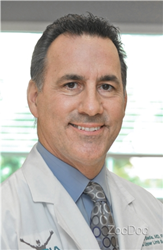
Dr. Alejandro Badia
Impingement syndrome occurs when the uppermost tendon of the rotator cuff – the supraspinatus tendon and its lubricating tissue or bursa — catches or rubs against the acromion, the bony arch of the shoulder, as an arm is raised.
MIAMI (PRWEB)
November 15, 2019
Unlike fine wine, shoulder joints do not get better with age. Risks for developing shoulder problems – most notably, shoulder impingement syndrome and rotator cuff disease – rise after age 50, says orthopedic surgeon Alejandro Badia MD, a specialist in treating diseases of the upper limbs.
Impingement syndrome occurs when the uppermost tendon of the rotator cuff – the supraspinatus tendon and its lubricating tissue or bursa — catches or rubs against the acromion, the bony arch of the shoulder, as an arm is raised. Repeated pinching of the tendon can cause it to become inflamed, swollen and persistently painful. Aggravation of the tendon also can weaken the shoulder, says Dr, Badia, founder and chief medical officer of the Badia Hand to Shoulder Center and OrthoNOW®.
“Bursitis is often an element of impingement syndrome,” Dr. Badia indicates. “That’s because, with age, the blood supply to the rotator cuff is diminished, resulting in small micro-tears in the tendons. These micro-tears can lead to tendinitis (inflamed tendon), bursitis or even larger tears.” Bursitis is an inflammation of the bursa tissue found in the narrow passageways between the shoulder tendons and muscles and the acromion and humerus bones.
“Shoulder impingement makes simple arm movements, like reaching up to put an item on a shelf or just moving an arm around to wash or scratch your back, very painful,” says Dr. Badia.
Unless properly treated, continued impingement of the shoulder tendon may damage it, sometimes causing it to tear away completely from the humerus bone – the long bone running from shoulder to elbow. An inflamed or torn tendon is a common cause of rotator cuff pain.
“Impingement syndrome is characterized by pain when an arm is elevated, pain that is worse at night, and inability to lie on the side of the affected shoulder,” Dr. Badia says. “A complete tear in the rotator cuff implies that the torn or weakened tendon has pulled away from the bone; in this case, the patient will either be physically unable to raise the arm or will experience severe pain when the arm is raised.”
Scanning studies suggest that as many 13 percent of those in their 50s and 20 percent of individuals 60 years of age or older have some degree of rotator cuff tear. That number reportedly jumps to 30 percent in the 70-and-older population.
Of course, shoulder joint issues are not just the domain of the elderly. In fact, after back and neck pain, shoulder pain is the third most common musculoskeletal complaint encountered by physicians, with a rotator cuff tear being a likely contributor.
Besides advancing age, repetitive overhead movement in certain occupations like painting, pipefitting, construction and airport baggage-handling, or in sports, including tennis, baseball and swimming, can increase risk for rotator cuff disease, especially since current exercise regimens in athletics “practically ignore strengthening of the rotator cuff,” Dr. Badia says, Poor posture, lifestyle factors like smoking, injury to the shoulder, and even genetics also play roles in development of rotator cuff disease.
Dr. Badia recommends patients contact an orthopedic specialist if experiencing deep, persistent shoulder pain that fails to respond to home care, including ice packs, heat therapy, rest, activity modification and over-the-counter anti-inflammatory medications; if the pain is interfering with routine, daily activities; or if the shoulder is weak and movement becomes significantly limited. A doctor will use X-rays, magnetic resonance imaging (MRI), CT scans or ultrasound to diagnose the problem.
Physical therapy and designed exercises, in combination with prescribed anti-inflammatory medications or corticosteroid injections in the shoulder joint, represent an initial course of treatment for less serious or partial rotator cuff tears and impingement.
Use of arthroscopic surgical techniques may be necessary to repair a complete tear in the rotator cuff or eliminate chronic, severe pain that does not respond to more conservative measures, says Dr. Badia. He adds that in the hands of an experienced shoulder specialist there is NO longer a reason to do any type of rotator cuff repair with an open surgery. He calls the shoulder a “demanding joint.”
Dr. Badia also has demonstrated success in using a bovine-collagen bioinductive implant – about the size of a postage stamp – to effectively treat rotator cuff disease.
“Clinical experience indicates that this implant promotes new tendon growth in the shoulder joint and can either halt progression of rotator cuff disease or prevent re-tearing of a tendon that has been surgically repaired,” says Dr. Badia.
Although rotator cuff disease cannot always be avoided, “people can take steps to reduce risks,” Dr. Badia says. He offers these tips:
- Exercise properly. Warm up before workouts or sports activities.
- Use proper techniques when lifting heavy objects and don’t strain shoulder joints by over-reaching.
- At work, avoid awkward positions or working too long with arms above the head; take breaks.
- Be mindful of posture; don’t slouch. Stop smoking.
Alejandro Badia, MD, FACS, internationally renowned hand and upper-limb surgeon and founder of Badia Hand to Shoulder Center and OrthoNOW®, a walk-in orthopedic care clinic. He is a member of the American Society for Surgery of the Hand, American Association for Hand Surgery and the American Academy of Orthopedic Surgeons and an honorary member of many international professional hand societies. Dr. Badia specializes in treating all problems related to the hand and upper extremities, including trauma, sports injury, joint reconstruction, nerve injuries and arthroscopic surgeries. http://www.OrthoNOWcare.com and http://www.drbadia.com.

